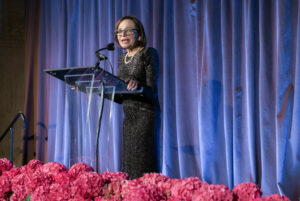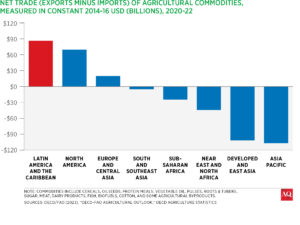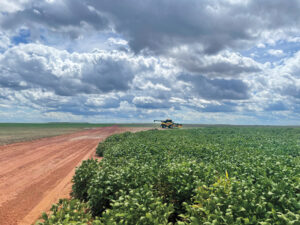This article is adapted from AQ’s special report on food security in Latin America | Leer en español | Ler em português
Food insecurity—where food quality or quantity is reduced—is one of the most pressing challenges of our time, directly impacting communities around the globe. According to research from Citi Global Perspectives and Solutions (GPS), one in three people globally endures moderate or severe food insecurity, and over 770 million people suffer from some form of malnutrition.
These sobering numbers are due to various environmental, social, and economic factors, including global conflict, climate change, the COVID-19 pandemic, and economic downturns that have slowed progress in recent years.
Just as the factors are multifaceted, so are the implications. Food insecurity is a detrimental social issue, but its economic implications are also severe. So, what is the cost of hunger? Citi GPS estimates the impact of malnutrition on the global economy to be as high as $3.5 trillion per year. And while finding a solution will also be costly, the report estimates that the economic benefits to society could reach up to $5.7 trillion annually by 2030.
As such, at the Citi Foundation, we see four key areas of investment needed to help advance food security:
1 • Enabling food access:
Nongovernmental organizations (NGOs) and for-profit social entrepreneurs are on the front lines, working to meet the needs of a growing number of individuals and families experiencing food insecurity and the economic strain of overall household expenses. Investing in their efforts to increase access to affordable and healthy food for low-income communities is essential.
2 • addressing affordability:
With record food prices and soaring energy costs, households are making near-impossible budgeting decisions. This is particularly true in low-income countries where people spend almost half of their income on food. Therefore, improving food affordability through community finance efforts can help reduce the financial burden on low-income communities.
3 • improving availability:
One of the six key strategies to address food insecurity in the 2022 UN State of Food Security and Nutrition in the World report is to reinvent the supply chain to lower the cost of food, particularly by shortening supply chains in urban areas so that residents can access fresh food. This can lead to positive community benefits, such as creating new jobs and businesses.
4 • supporting community resilience:
The growing frequency and intensity of natural disasters and conflict, along with an increasingly volatile world, is jeopardizing the global food system. The potential harm to lives, livelihoods and quality of life can be reduced by implementing strategies to manage disaster-related risks. It is critical to invest in community organizations that are working to increase the resources available for low-income communities to more effectively prepare for and respond to disruptions in food security during a crisis.
Latin America continues to battle with food insecurity. Too many people in the region go hungry every day. According to the United Nations, hunger impacted as many as 56.6 million people in the hemisphere in 2021. Meanwhile, we see community-based organizations with new and emerging ideas, technologies, and approaches addressing these key areas of access, affordability, availability, and community resilience that are ripe for meaningful investment. The region can—and will—benefit from these solutions.
Philanthropy as a tool for innovation
Catalytic funding is a vital way in which the private sector can help address some of society’s most pressing challenges, including food insecurity. Philanthropy is a critical tool to catalyze solutions because it can infuse innovative solutions with patient, flexible capital and bring a wide range of nonprofit partners to the table without an expectation of financial returns.
Through the Citi Foundation’s Global Innovation Challenge model, we seek to address urgent community needs and identify and provide philanthropic support to community organizations developing innovative solutions to address social and economic challenges facing low-income communities worldwide. With millions of people globally suffering from some form of malnutrition, food insecurity is one of the greatest challenges facing low-income populations.
The 50 recipient community organizations of the Global Innovation Challenge are spearheading game-changing solutions that improve food access, affordability, availability and community resilience around the world. Their innovative solutions center around providing technological advancements, training and mentorship, expanding access to markets and investors, promoting environmentally friendly farming practices, and more. The grants span two years, and the goal is to pilot or expand each organization’s innovative ideas that are designed to improve food security and strengthen the financial health of low-income families and communities.
Take The Hunger Project, for instance. This initiative enhances the leadership and entrepreneurial skills of Indigenous women in Southern Mexico through technical training to launch community-driven food businesses. The strategy is designed to foster lasting progress that extends far beyond the life of the grant. The Hunger Project projects that their efforts will bring sustainable access to diverse, nutritious food and increase household income for over 2,000 rural, Indigenous individuals while reaching more than 3,000 others through local markets.

Another example is Bancos de Alimentos ARGENTINA (BAA). They are expanding access to food in Argentina by providing training at food banks and improving their infrastructure. The efforts increase the delivery of healthy food to those in need, with a focus on women and children. In Chile, Red de Alimentos is broadening its efforts to rescue more food from disposal nationwide by enhancing its app and developing partnerships with new food providers to reach underserved groups, including women, migrants and youth. In Guatemala and Honduras, Groundswell International is establishing community grain and seed reserves and promoting sustainable farming methods with a focus on supporting women and Indigenous communities.
Across the board, these solutions center innovation and training to accelerate the reach and impact of solutions.
During our Global Innovation Challenge, these grantees have access to technical assistance and a learning community facilitated by IDEO.org, a nonprofit focused on designing products and services in the social impact sector. Through wrap-around services, grantees can collaborate, share lessons learned, and exchange best practices.
Our goal? To leverage philanthropy as a catalyst for innovation, specifically as it pertains to the issue of food security and the financial well-being of communities and families. Each community organization in this inaugural cohort brings unique perspectives, relationships, capabilities and ideas to the issue of food security.
For lasting impact, influence is key
It’s essential to think about our influence. No organization can single-handedly solve societal issues through grant support alone—and that’s OK. Influence is about going beyond the funding. Funders can help put game-changing solutions on the map. This is especially important as we think about local organizations in Latin America, many of which lack the size and resources to absorb large cash infusions to scale their projects. By elevating new approaches, we can help shift the headlines from solely pointing out the issues to focusing on solutions and the community leaders driving them. Further, as ideas are amplified, they can inspire investment as well as influence new effective models elsewhere.
Influence also means playing a leadership role in bringing others to the table. The magnitude of the food crisis and the need in communities worldwide requires the public, private, civic and philanthropic sectors to collaborate in new ways and build momentum to effect meaningful change at more intensive speeds than ever before. With so many sectors interested in addressing food security, we have a collective opportunity to draw from the range of tools and resources at our disposal to drive long-lasting change.
Nearly a decade ago, the United Nations established its Sustainable Development Goals, noting its second goal (SDG2) to “end hunger, achieve food security and improved nutrition and promote sustainable agriculture” worldwide by 2030. Today, this goal is just as important, and with 2030 rapidly approaching, I am reminded of the urgency of our collective efforts.
In Mexico, Argentina, Chile, Guatemala, Honduras and beyond, the groundbreaking solutions in Latin America, as shown by the Global Innovation Challenge grantees, are examples of how progress is possible. They also are examples of how further investment will be required to continue scaling. Now is the time to come together and continue collaborating across all sectors and organizations of all sizes to move the needle on food security for the future.












